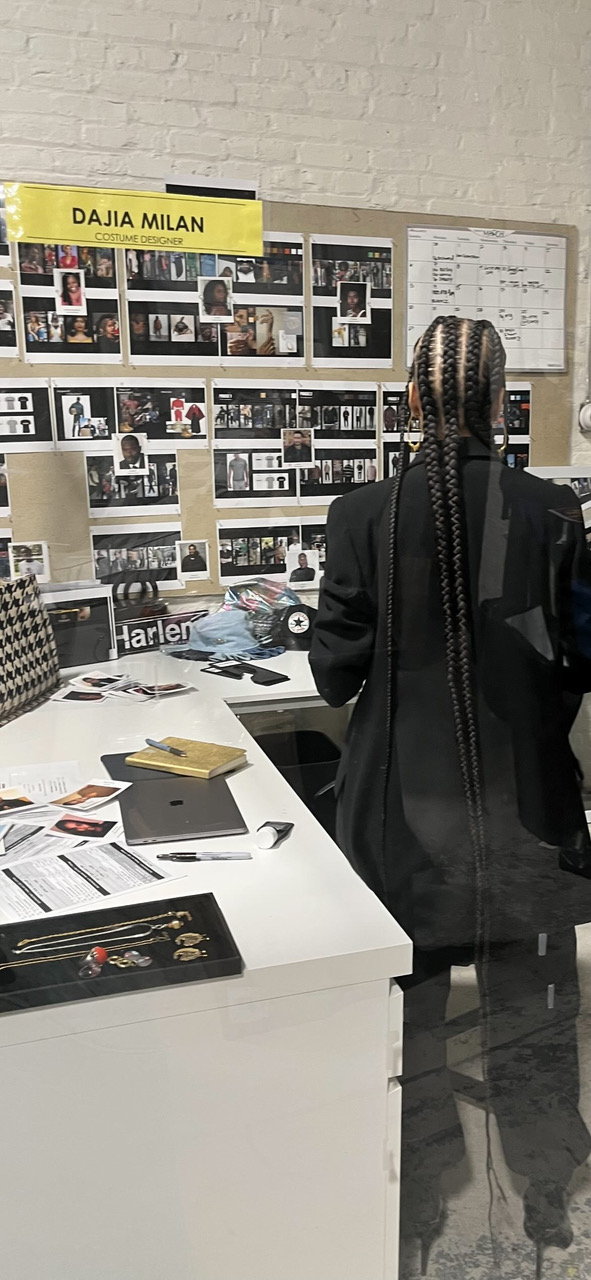When Mase said Harlem was on the rise, he might’ve been referring to Manhattan Avenue, aka Money Ave., the block Costume Designer Dajia Milan grew up on until moving just a little ways away to Morningside Heights.
As a child, the New York native’s dreams looked more like Save the Last Dance and/or Black Swan, as her first love was the ballet – Arthur Mitchell of the Dance Theatre of Harlem is her uncle – and she even performed as a rhythmic gymnast for the Wendy Hillard Foundation. Her transition into fashion was influenced by family friend and legend Dapper Dan, who taught her how to draw and gave her fashion history lessons at his home. After a stint in styling, she took time to find an alternative role. Ms. Milan knew she wanted to stay in a space where she could dress people and create characters. Like most, she assumed actors supplied their own wardrobe. However, after learning that costume designer was a career, she embarked on a new journey. In 2022, she holds that same position after having worked on numerous films and television series. Except in Dajia’s case, after a relentless amount of hustle and hassle, her title now reads Head Costume Designer.
How were you introduced to costume design?
The introduction to this niche market came while I was styling. After I had decided that the world of styling wasn’t for me, I was trying to figure out what else I could do within the space. I remember googling where the garments from some of the films we’ve all seen came from and who put these looks together, and knew that it would make sense. That’s how I started coming across the “costume designer” title and learning that there are people solely responsible for this part of the production. For a long time, and this dates to my childhood, I assumed that the cast members were using their own clothes for the projects they were in.
As my research continued, I started learning about Ruth E. Carter, Edith Head, and Colleen Atwood, and from that moment, it was like, how do I get there? So I started reaching out to as many friends and people I knew in the industry for advice on how I get involved. Of course, you don’t always receive the best advice from folks because many aren’t interested in sharing their secrets. A friend from college introduced me to a designer who gave me my first job as a production assistant on an indie film which allowed me to gain a ton of experience. I held many different roles during that film because there are many titles in this business before you make it to being a designer.
When you first decided you would pursue this niche industry. Where were you in life, and what was your conversation like?
I was a styling assistant at that point. I was in the midst of graduating college; the pay wasn’t amazing, plus I was tired of waiting on invoices to be paid out. My thought was, ‘is this stable enough for the life I want for myself? Is this lifelong?’ I had to sit with myself because I knew I couldn’t be a struggling stylist forever. It may look glamorous via social media, and you’re in certain places and around specific people, but that doesn’t pay the bills.
What questions would you ask a director to ensure you understand their vision?
Well, once we receive the script as a team, we work to break the script down and envision what these characters are going through. From there, we take our thoughts, combine our visions, and then present them in a way that a director or producer will understand and gravitate towards. Personally, I will reread a script more than once before I start diving into what the clothing will be. First, I need to feel the emotion to fully grasp who the character is or will become. Afterward, I ask about their feelings, background, upbringing, mood, and the overall message that will be told within the character’s story via their wardrobe.
What type of productions have you designed costumes for?
I was the assistant designer on the last season of POSE, which is hands down the most memorable project I have ever worked on thus far. In addition, I worked on Hulu’s Wu-Tang: An American Saga and on Halle Berry’s Bruised. All three are moments I’ve never going to forget because of the journey and fulfillment of them all. I worked on Season 3 of The Path for Hulu, Season 2 of Flatbush Misdemeanors for Showtime, Dead Ringers for Amazon, and a few I cannot mention but count them as an honorable mention.
Out of all the ones you named, which took the most of you?
POSE took the most out of me. We were shooting that final season at the height of the Covid-19 pandemic. Finding period pieces with virtually zero turnarounds for the showrooms and stores receiving stock made buying vintage extremely difficult. Sometimes we had to shut down and then come back because the virus kept making things challenging. The project lasted almost a year because of that. Also, creating those out-of-the-world pieces that the audience saw on the show with small resources and small budgets when prices started to increase enhanced our complications. Also, vintage is a hit or miss. When you’re out shopping for a show, you may think you’ve found what you’re looking for, but then you come back to the costume shop with nothing, and then we must pivot and say okay what are we going to do. Truthfully, we started shopping and sourcing clothes through Instagram. We did build a lot of the custom ballroom looks, but we only had four tailors and were also dressing all the background actors and extras, so it was a lot!





